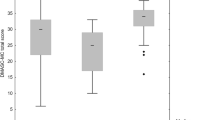Abstract
The purpose of this study was to test the relationship between IQ and physical aggression in a nonclinical-nonforensic male sample in a laboratory setting. Thirty males completed an abbreviated version of the Wechsler Adult Intelligence Scale—Revised. Aggression was measured using a modified version of the Taylor reaction-time (RT) aggression paradigm in which subjects competed on a RT task and both received and delivered shocks to a fictitious opponent in provoking and nonprovoking conditions. Provocation conditions (High and Low) were defined by the intensity of shocks the subjects received. Results demonstrated strong inverse correlations between IQ and aggressive behavior under both High and Low Provocation conditions.
Similar content being viewed by others
References
Bernstein, S., Richardson, D., & Hammock, G. (1987). Convergent and discriminant validity of the Taylor and Buss measures of physical aggression.Aggressive Behavior, 13, 15–24.
Brooker, B. H., & Cyr, J. J. (1986). Tables for clinicians to use to convert WAIS-R short forms.Journal of Clinical Psychology, 42, 982–986.
Buikhuisen, W. (1987). Cerebral dysfunctions and persistent juvenile delinquency. In S. A. Mednick, T. E. Moffitt, & S. A. Stack (Eds.),The causes of crime: New biological approaches (pp. 168–184). New York: Cambridge University Press.
DeJong, J., Virkkunen, M., & Linnoila, M. (1992). Factors associated with recidivism in a criminal population.Journal of Nervous and Mental Disease, 180, 543–550.
DiLalla, L. F., & Gottesman, I. I. (1991). Biological and genetic contributors to violence: Widom's untold tale.Psychological Bulletin, 109, 125–129.
Elliott, F. A. (1992). Violence: The neurological contribution: An overview.Archives of Neurology, 49, 595–603.
Giancola, P., & Zeichner, A. (1994). Construct validity of a competitive reaction-time aggression paradigm.Aggressive Behavior (in press).
Heilbrun, A. B. (1979). Psychopathy and violent crime.Journal of Consulting and Clinical Psychology, 47, 509–516.
Hirschi, T., & Hindelang, M. J. (1977). Intelligence and delinquency: A revisionist review.American Sociological Review, 42, 571–587.
Hodges, K., & Plow, J. (1990). Intellectual ability and achievement in psychiatrically hospitalized children with conduct, anxiety, and affective disorders.Journal of Consulting and Clinical Psychology, 58, 589–595.
Kandel, E., Mednick, S. A., Kirkegaard-Sorensen, L., Hutchings, B., Knop, J., Rosenberg, R., & Schulsinger, F. (1988). IQ as a protective factor for subjects at high risk for antisocial behavior.Journal of Consulting and Clinical Psychology, 56, 224–226.
McGarvey, B., Gabrielli, W. F., Bentler, P. M., & Mednick, S. A. (1981). Rearing social class, education, and criminality: A multiple indicator model.Journal of Abnormal Psychology, 90, 354–364.
Moffitt, T. E., & Silva, P. A. (1988). IQ and delinquency: A test of the differential detection hypothesis.Journal of Abnormal Psychology, 97, 330–333.
Richters, J. E. (1993). Community violence and children's development: Toward a research agenda for the 1990s.Psychiatry, 56, 3–6.
Stark, R. (1975).Social problems. New York: Random House.
Tarter, R. E., Hegedus, A. M., Winsten, N. E., & Alterman, A. I. (1984). Neuropsychological, personality, and familial characteristics of physically abused delinquents.Journal of the American Academy of Child Psychiatry, 23, 668–674.
Taylor, S. (1967). Aggressive behavior and physiological arousal as a function of provocation and the tendency to inhibit aggression.Journal of Personality, 35, 297–310.
Taylor, S., Gammon, C., & Capasso, D. (1976). Aggression as a function of the interaction of alcohol and threat.Journal of Personality and Social Psychology, 34, 938–941.
White, J. L., Moffitt, T. E., & Silva, P. A. (1989). A prospective replication of the protective effects of IQ in subjects at high risk for juvenile delinquency.Journal of Consulting and Clinical Psychology, 57, 719–724.
Wolfe, B. M., & Baron, R. A. (1971). Laboratory aggression related to aggression in naturalistic social situations.Psychonomic Science, 24, 193–194.
Yeudall, L., Fromm-Auch, D., & Davies, P. (1982). Neuropsychological impairment of persistent delinquency.Journal of Nervous and Mental Disease, 170, 257–265.
Author information
Authors and Affiliations
Rights and permissions
About this article
Cite this article
Giancola, P.R., Zeichner, A. Intellectual ability and aggressive behavior in nonclinical-nonforensic males. J Psychopathol Behav Assess 16, 121–130 (1994). https://doi.org/10.1007/BF02232723
Accepted:
Issue Date:
DOI: https://doi.org/10.1007/BF02232723




